
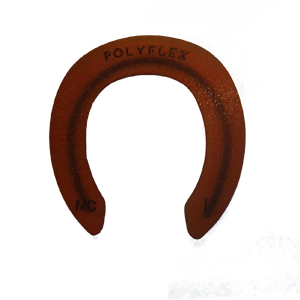

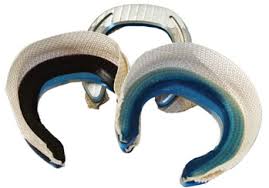
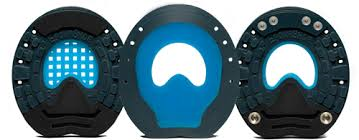
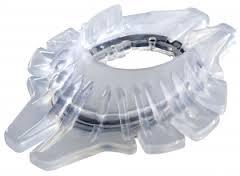
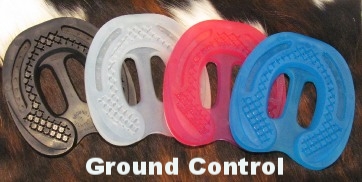
Composite shoes are horseshoes made from durable composite materials—plastics similar to those used in skateboard wheels—that provide unique advantages compared to traditional steel or aluminum shoes.
Epona Shoe
Glued and awaiting casting tape for stability and durability. The pink is dental impression material to protect the heel bulbs from the cast possibly rubbing.
Composite shoes can be used for:
For rehabilitation — supporting horses with conditions such as laminitis, founder, or arthritis.
For performance horses — maximizing shock absorption and comfort during demanding work.
For transition — helping horses build sole depth and vertical height when moving from metal shoes to barefoot.
For temporary protection — offering an alternative to boots for travel or seasonal riding when extra protection is needed but boots feel cumbersome or unreliable.
Benefits of Composite Shoes
Provide caudal support — engage and support the back half of the hoof and frog.
Improve breakover — shoes can be set back or beveled for easier, more efficient movement.
Gentle on the hoof wall — no nail damage when glued, ideal for thin-walled hooves or painful horses.
Non-traumatic attachment — glue-on application is especially beneficial for sore or laminitic horses.
Corrective applications — foal extensions can help address limb deviations.
Lightweight design — reduces strain on joints and tendons.
Eliminates shock and concussion — enhancing comfort for both rehabilitation and performance horses.
Things to Consider About Composite Shoes
Composite shoes are often a means to an end rather than a permanent solution. The ultimate goal may be to transition the horse to traditional shoes, barefoot, or boots.
In our experience, three shoeing cycles are usually enough to create significant, lasting, and positive changes. At that point, we reassess, take new radiographs if needed, and adjust the rehabilitation plan accordingly.
Some horses do benefit from wearing composite shoes year-round, depending on their individual needs.
Cost of Composite Shoes vs. Metal
Composite shoes are typically more expensive than traditional metal shoes, but in most cases, the benefits far outweigh the added cost.
Because composite shoes require advanced knowledge and skill to select, fit, modify, and apply, the cost reflects both the expertise involved and the materials used. Material costs are higher—especially for glue-on applications or therapeutic cases—so the price for application generally starts at $300+. This estimate includes time, trim, preparation, materials, and the application of two shoes. Additional costs may apply when using dental impression material, pour-in pads, or casting materials.
Therapeutic shoeing should be viewed as an investment in your horse’s long-term soundness and comfort. Addressing and correcting an issue up front often costs less in the long run than managing a chronic problem over time.

